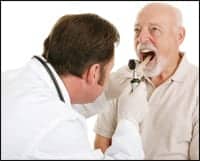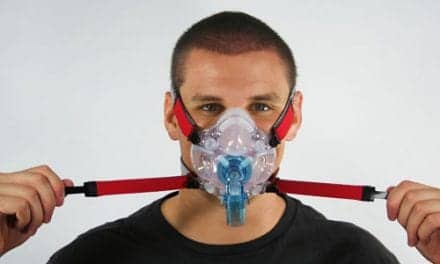 |
Sleep-disordered breathing (SBD) is highly prevalent in the general population with obstructive sleep apnea (OSA) affecting approximately 15% of men and 5% of women between the ages of 30 and 60 years.1 SDB can lead to significant cardiovascular consequences2 and is effectively treated with continuous positive airway pressure (CPAP).3,4 Like all chronic therapies, compliance with CPAP is difficult to maintain over time and between 5% and 50% of patients refuse CPAP therapy initially and another 12% to 25% may discontinue CPAP within 3 years.5,6 In view of compliance issues with CPAP, besides regular visits with a sleep specialist on an annual basis, alternative modalities to treat OSA have been evaluated, including oral appliances and surgical measures. The case of DS illustrates how one patient was able to overcome CPAP compliance problems with surgical treatment and adjustments to CPAP pressure.
BACKGROUND
Surgical therapies aim to improve the airway by increasing its surface area, bypassing the pharyngeal airway, or removing a specific pathological lesion, and include tonsillectomy with uvulopalatopharyngoplasty (UPPP), laser midline glossectomy, maxillomandibular advancement, and tracheostomy among many others.7 Surgical treatments are a viable option in carefully chosen patients with obstructive sleep apnea.8,9 To be effective, a logical and systematic approach to clinical evaluation, treatment planning, surgical execution, and preoperative management is necessary to maximize safety and improve outcomes.
UPPP is probably the most common surgical procedure performed in the United States for OSA since its introduction in 1981 by Dr Fujita.10,11 The procedure starts with performing tonsillectomy (if it has not been done previously), trimming and reorientation of posterior and anterior tonsillar pillars, followed by excision of the uvula and posterior palate.10,11 The procedure is done under general anesthesia and usually requires hospital admission. The effectiveness of UPPP has ranged from 13% to 50% in various studies12,13 depending on the definition of surgical response. If response is measured as a 50% reduction in apnea-hypopnea index (AHI) or postoperative respiratory disturbance index (RDI), a higher response rate is seen14 compared to using a postoperative apnea-hypopnea index of ≤ 5 or ≤ 10 events per hour.8 UPPP has also been associated with postoperative complications like velopharyngeal insufficiency, bleeding nasopharyngeal stenosis, and voice change among other complications.
CASE STUDY
DS is a 35-year-old white male (body mass index of 31 kg/m2) who presented to the sleep disorders center with a history of moderate-loud snoring at night and apneic episodes noted by his wife. He had excessive daytime sleepiness and was having problems keeping himself awake at work and had been reprimanded by his supervisor. He had no medical complaints and was not taking any medication.
His Epworth Sleepiness Score was increased at 10. He had an initial split night sleep study done that showed an AHI of 23 events per hour and an arousal index (AI) of 24 events per hour. He had loud snoring on his back as well as his side. He was titrated on CPAP to 9 cm H2O but had problems using CPAP due to intolerance of CPAP pressure despite changing multiple masks, use of heated humidity, and desensitization with CPAP while awake.
In view of his CPAP intolerance, an ENT consult was requested, and he was counseled by the ENT physician on the possible outcomes and complications of surgery. He underwent a UPPP under general anesthesia and had mild velopharyngeal insufficiency, causing food to regurgitate in his nasal passages, which resolved over a month. He continued to be mildly sleepy during the daytime and snored on his back but not on his side; a repeat sleep study done 6 months after his surgery showed an AHI of zero but an AI of 30 events per hour. The majority of his arousals were respiratory effort related arousals (RERAs) and resolved during the second half of the night with CPAP of 5 cm H2O, which he is able to tolerate. He continues to do well on CPAP therapy and has reported resolution of his symptoms of daytime sleepiness.
His case illustrates how UPPP can be used along with CPAP in the management of obstructive sleep apnea. Similar reduction in CPAP pressures and improvement in compliance with CPAP have been documented in studies.15
DISCUSSION
It is important to diagnose obstructive sleep apnea based on the results of a sleep study read by a certified sleep specialist. Given the proven efficacy of CPAP in patients with moderate to severe symptoms and significant sleep-disordered breathing, CPAP with weight reduction and decrease in alcohol intake should be recommended as first-line treatment, with surgery reserved for relatively younger patients (age ~35 years), with BMI ~30 and AHI ≤ 40.8
The selection of procedure depends on the health status and medical condition of the patient, and the surgical endpoint should be discussed with the patient prior to planning the procedure. The available evidence does not currently support the widespread use of surgical interventions in the management of unselected patients with obstructive sleep apnea.12 The attractiveness of an apparently curative intervention for sleep apnea should be balanced against the uncertainty surrounding its safety, continued effectiveness, and inconsistent impact on subjective and objective markers of disease in patients with OSA.12
Akram Khan, MD, is a board-certified sleep specialist and an assistant professor of pulmonary, critical care, and sleep medicine at University of Florida College of Medicine, Jacksonville. He is also the co-medical director of the Sleep Disorders Center at Shands Jacksonville. Khan can be reached at [email protected].
References
- Young T, Palta M, Dempsey J, Skatrud J, Weber S, Badr S. The occurrence of sleep-disordered breathing among middle-aged adults. N Engl J Med. 1993;328:1230-1235.
- Shahar E, Whitney CW, Redline S, et al. Sleep-disordered breathing and cardiovascular disease. Cross-sectional results of the Sleep Heart Health Study. Am J Respir Crit Care Med. 2001;163:19-25.
- Jenkinson C, Davies RJ, Mullins R, Stradling JR. Comparison of therapeutic and subtherapeutic nasal continuous positive airway pressure for obstructive sleep apnoea: a randomised prospective parallel trial. Lancet. 1999;353:2100-2105.
- Ballester E, Badia JR, Hernandez L, et al. Evidence of the effectiveness of continuous positive airway pressure in the treatment of sleep apnea/hypopnea syndrome. Am J Respir Crit Care Med. 1999;159:495-501.
- Engleman HM, Martin SE, Douglas NJ. Compliance with CPAP therapy in patients with the sleep apnoea/hypopnoea syndrome. Thorax. 1994;49:263-266.
- Engleman HM, Wild MR. Improving CPAP use by patients with the sleep apnoea/hypopnoea syndrome (SAHS). Sleep Med Rev. 2003;7:81-99.
- Sher AE. Upper airway surgery for obstructive sleep apnea. Sleep Med Rev. 2002;6:195-212.
- Khan A, Ramar K, Friedman O, Pallanch JF, Olson EJ. Outcomes of uvulopalatopharyngoplasty in patients with obstructive sleep apnea. Chest Meeting Abstracts. 2007;132:504.
- Sher AE, Schechtman KB, Piccirillo JF. The efficacy of surgical modifications of the upper airway in adults with obstructive sleep apnea syndrome. Sleep. 1996;19:156-177.
- Fujita S, Conway WA, Zorick FJ, et al. Evaluation of the effectiveness of uvulopalatopharyngoplasty. Laryngoscope. 1985;95:70-74.
- Fujita S, Conway W, Zorick F, Roth T. Surgical correction of anatomic abnormalities in obstructive sleep apnea syndrome: uvulopalatopharyngoplasty. Otolaryngol Head Neck Surg. 1981;89:923-934.
- Elshaug AG, Moss JR, Hiller JE, Maddern GJ. Upper airway surgery should not be first line treatment for obstructive sleep apnoea in adults. BMJ. 2008;336:44-45.
- Larsson LH, Carlsson-Nordlander B, Svanborg E. Four-year follow-up after uvulopalatopharyngoplasty in 50 unselected patients with obstructive sleep apnea syndrome. Laryngoscope. 1994;104:1362-1368.
- Larsson H, Carlsson-Nordlander B, Svanborg E. Long-time follow-up after UPPP for obstructive sleep apnea syndrome. Results of sleep apnea recordings and subjective evaluation 6 months and 2 years after surgery. Acta Otolaryngol. 1991;111:582-590.
- Zonato AI, Bittencourt LR, Martinho FL, Gregorio LC, Tufik S. Upper airway surgery: the effect on nasal continuous positive airway pressure titration on obstructive sleep apnea patients. Eur Arch Otorhinolaryngol. 2006;263:481-486.



